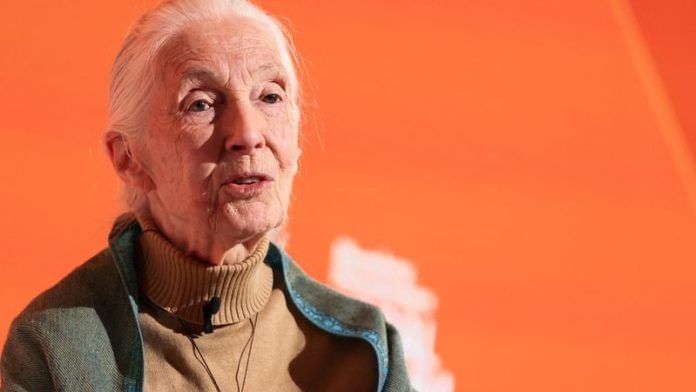New Delhi: The world has lost a legend. Dr Jane Goodall, the British primatologist who changed the way we see animals and inspired millions to protect nature, passed away on Wednesday at the age of 91. She was more than a scientist. She was a storyteller, a campaigner, and a global voice for the wild.
Jane Goodall was born in London in 1934. Even as a child, she was curious about animals. She loved reading books about wild creatures and spent hours watching them. Once, as a little girl, she sat quietly in a chicken coop for hours just to see how a hen laid an egg. That patience and love for animals never left her.
In 1960, when she was 26, she travelled to Tanzania to study chimpanzees at Gombe Stream National Park. She had no formal degree in science, no laboratory, and no equipment except a notebook and binoculars. But she had passion, courage, and determination. What she discovered there would transform science forever.
Ground-breaking research
Until Jane, most scientists believed animals were very different from humans. But her observations proved otherwise. She was the first to see chimpanzees using tools—taking sticks, stripping the leaves, and fishing termites from the ground. This discovery shocked the world. At that time, scientists thought only humans used tools. Her research proved that the line between humans and animals was not as clear as people once believed.
Jane also showed that chimpanzees have emotions, personalities, and complex social lives. She gave them names instead of numbers, describing their unique characters—some playful, some aggressive, some gentle. She watched mothers carefully care for their young, friends grooming each other, and even groups going to war. She brought their world closer to ours, making people everywhere realise that chimpanzees are our closest relatives.
Her first book, In the Shadow of Man, narrated the story of those early years in Gombe. Later, she published The Chimpanzees of Gombe, a scientific classic. Her work created one of the longest-running wildlife studies in history and remains a foundation of primatology.
Mewa Singh, India’s leading primatologist, remembers Jane with deep respect. “I met Jane Goodall several times and have spent hours talking with her; she was truly an inspirational force for everyone in the field of wildlife, especially those into primatology. What made her remarkable was that she had no formal training in biology when she began,” he added.
Singh said that Louis Leakey, the great anthropologist, believed women would understand apes better and sent Jane to study chimpanzees, Dian Fossey to study gorillas, and Biruté Galdikas to study orangutans.
Also read: Major Agha Humayun Amin—Pakistan army’s prodigal son didn’t care for nationalism or religion
Towering figure in primatology
Jane went into the forests with her mother, travelling long hours in a boat to reach the remote Gombe reserve. At first, the chimps kept their distance. Then one evening, as she sat on a rock at sunset, a chimp came and sat close to her. That moment inspired the title of her first book—In the Shadow of Man. From there, her research changed the world. She became a towering figure in primatology and global conservation. For all of us, it felt as if we were growing up following her footsteps.
In 1977, she founded the Jane Goodall Institute, which today runs projects across Africa and the world. It works not only for chimpanzees but also for local communities, education, and sustainable development. In the 1980s, Jane turned from pure research to conservation. She saw forests vanishing, chimpanzee numbers dropping, and local people struggling. She realised that to protect animals, we must also care for people.
In 1991, she started ‘Roots & Shoots’—a youth program that empowers young people to create projects for the environment, animals, and people. It began with a small group of Tanzanian students and grew into a worldwide movement across more than 100 countries.
Jane’s message was always simple but powerful: “Every individual can make a difference.” She repeated this everywhere she went, whether speaking at the United Nations or at a village school. She carried a stuffed toy chimpanzee named Mr H as a symbol of hope and kindness.
Over her six-decade career, Jane received many awards. She was named a Dame of the British Empire, a UN Messenger of Peace, and a winner of dozens of scientific and humanitarian honours. Yet she always stayed humble, describing herself simply as “a girl who loved animals.”
Even in her later years, she travelled more than 300 days a year, meeting people and inspiring them. She never gave up her mission to speak for animals and for the Earth.
Jane’s passing leaves the world poorer, but her spirit will live on in every forest, every conservation project, and every young person she inspired. She once said, “Only if we understand, can we care. Only if we care will we help. Only if we help, shall all be saved.”
Today, as we mourn her, we also celebrate a life of courage, compassion, and hope. Jane Goodall showed us that humans are not apart from nature, but part of it. She will always be remembered as the woman who sat among chimpanzees and gave them a voice for the world.
Tejus RS is an intern from ThePrint School of Journalism.
(Edited by Saptak Datta)





